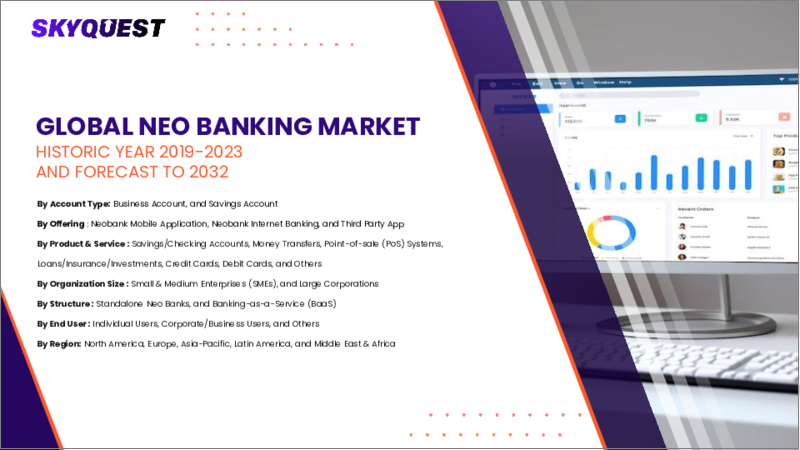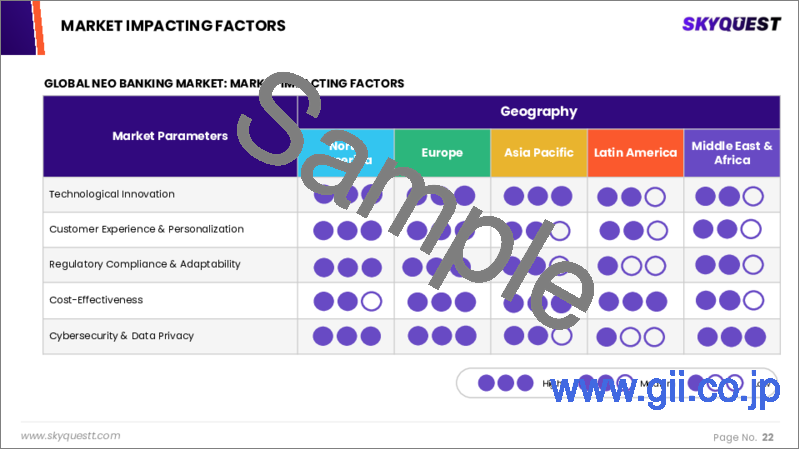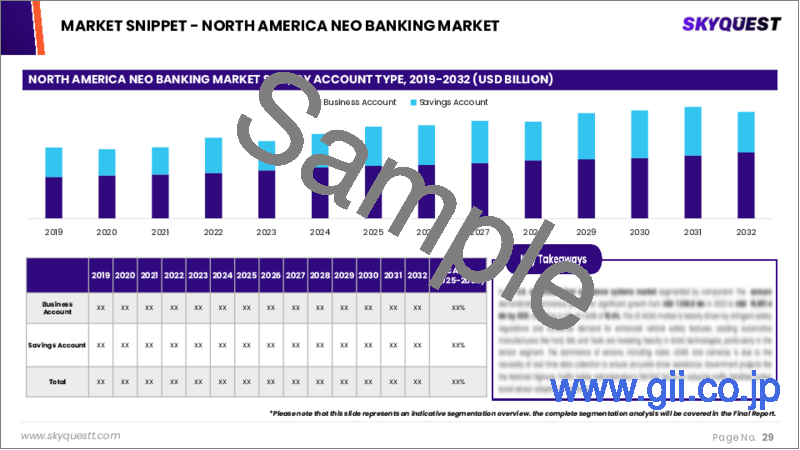|
|
市場調査レポート
商品コード
1607683
ネオバンキング市場規模、シェア、成長分析、口座タイプ別、製品・サービス別、用途別、地域別- 産業予測、2024~2031年Neobanking Market Size, Share, Growth Analysis, By Account Type (Business, Savings), By Product & Service (Saving Account, Loans), By Application By Region - Industry Forecast 2024-2031 |
||||||
|
|||||||
| ネオバンキング市場規模、シェア、成長分析、口座タイプ別、製品・サービス別、用途別、地域別- 産業予測、2024~2031年 |
|
出版日: 2024年12月04日
発行: SkyQuest
ページ情報: 英文 242 Pages
納期: 3~5営業日
|
全表示
- 概要
- 目次
ネオバンキングの世界市場規模は、2022年に451億8,000万米ドルと評価され、予測期間中(2024~2031年)のCAGRは52.93%で、2023年の724億7,000万米ドルから2031年には2兆1,683億1,000万米ドルに成長する見通しです。
銀行業務における利便性への要求の高まりが、使いやすいモバイル・アプリやオンライン・プラットフォームを通じてブランチレス・バンキング・ソリューションを提供するネオバンクの成長を後押ししています。スマートフォンやインターネットの利用が世界的に急増するにつれ、より多くの消費者がこうしたデジタルバンクを利用するようになり、そのサービスは急速に有効性を増しています。既存の銀行は新技術の導入に遅れをとっているため、機敏な新興企業はサービスを業務プロセスと統合し、低コストを実現することで、大きな市場シェアを獲得しています。ネオバンクは顧客中心のアプローチを優先し、予測インテリジェンス、簡素化されたプロセス、個別化された洞察を活用しています。MEDICI India Fintechの報告によると、インドのネオバンクは2019年だけで2億米ドル以上を調達しています。
目次
イントロダクション
- 調査の目的
- 調査範囲
- 定義
調査手法
- 情報調達
- 二次データと一次データの方法
- 市場規模予測
- 市場の前提条件と制限
エグゼクティブサマリー
- 世界市場の見通し
- 供給と需要の動向分析
- セグメント別機会分析
市場力学と見通し
- 市場概要
- 市場規模
- 市場力学
- 促進要因と機会
- 抑制要因と課題
- ポーター分析と影響
- 競争企業間の敵対関係
- 代替品の脅威
- 買い手の交渉力
- 新規参入業者の脅威
- 供給企業の交渉力
主な市場の考察
- 重要成功要因
- 競合の程度
- 主な投資機会
- 市場エコシステム
- 市場の魅力指数(2023年)
- PESTEL分析
- マクロ経済指標
- バリューチェーン分析
- 価格分析
- 技術の進歩
- 規制情勢
- ケーススタディ
- 顧客と購買基準の分析
ネオバンキング市場規模:口座タイプ別 & CAGR(2024-2031)
- 市場概要
- ビジネスアカウント
- 普通預金口座
ネオバンキング市場規模:製品・サービス別 & CAGR(2024-2031)
- 市場概要
- 普通預金/当座預金口座
- 支払いと送金
- モバイルバンキング
- ローン/保険/投資
- クレジットカード
- その他
- 貸金庫
- 資金管理ツール
ネオバンキング市場規模:用途別 & CAGR(2024-2031)
- 市場概要
- 企業
- 個人
- その他
ネオバンキング市場規模:地域別 & CAGR(2024-2031)
- 北米
- 米国
- カナダ
- 欧州
- 英国
- ドイツ
- スペイン
- フランス
- イタリア
- その他欧州地域
- アジア太平洋地域
- 中国
- インド
- 日本
- 韓国
- その他アジア太平洋地域
- ラテンアメリカ
- ブラジル
- その他ラテンアメリカ地域
- 中東・アフリカ
- GCC諸国
- 南アフリカ
- その他中東・アフリカ
競合情報
- 上位5社の比較
- 主要企業の市場ポジショニング(2023年)
- 主な市場企業が採用した戦略
- 市場の最近の動向
- 企業の市場シェア分析(2023年)
- 主要企業の企業プロファイル
- 会社概要
- 製品ポートフォリオ分析
- セグメント別シェア分析
- 収益の前年比比較(2021-2023)
主要企業プロファイル
- Chime(USA)
- Revolut(UK)
- Monzo(UK)
- Starling Bank(UK)
- N26(Germany)
- SoFi(USA)
- Varo Bank(USA)
- Current(USA)
- Acorns(USA)
- NorthOne(USA)
- Brex(USA)
- MoneyLion(USA)
- Tinkoff Bank(Russia)
- Judo Bank(Australia)
- Nubank(Brazil)
- Zopa(UK)
- BankMobile(BM Technologies)(USA)
- Aspiration(USA)
- Paytm Payments Bank(India)
- GoHenry(UK)
結論と推奨事項
Global Neobanking Market size was valued at USD 45.18 Billion in 2022 and is poised to grow from USD 72.47 Billion in 2023 to USD 2168.31 Billion by 2031, at a CAGR of 52.93% during the forecast period (2024-2031).
The increasing demand for convenience in banking is propelling the growth of neobanks, which offer branchless banking solutions through user-friendly mobile apps and online platforms. As smartphone and internet usage soars globally, more consumers are turning to these digital banks, which rapidly validate their services. Established banks are lagging in adopting new technologies, allowing agile startups to capture significant market share by integrating services with business processes and providing lower costs. Neobanks prioritize customer-centric approaches, leveraging predictive intelligence, simplified processes, and personalized insights. To solidify their market presence, these fintech entities are engaging in mergers, partnerships, and product innovations, supported by substantial venture capital investments-highlighted by Indian neobanks raising over USD 200 million in 2019 alone, as reported by MEDICI India Fintech.
Top-down and bottom-up approaches were used to estimate and validate the size of the Global Neobanking market and to estimate the size of various other dependent submarkets. The research methodology used to estimate the market size includes the following details: The key players in the market were identified through secondary research, and their market shares in the respective regions were determined through primary and secondary research. This entire procedure includes the study of the annual and financial reports of the top market players and extensive interviews for key insights from industry leaders such as CEOs, VPs, directors, and marketing executives. All percentage shares split, and breakdowns were determined using secondary sources and verified through Primary sources. All possible parameters that affect the markets covered in this research study have been accounted for, viewed in extensive detail, verified through primary research, and analyzed to get the final quantitative and qualitative data.
Global Neobanking Market Segmental Analysis
Global Neobanking Market is segmented by Account Type, Product & Service, Application and region. Based on Account Type, the market is segmented into Business Account, Savings Account. Based on Product & Service, the market is segmented into Savings/Checking Accounts, Payments & Money Transfers, Mobile Banking, Loans/Insurance/Investments, Credit Cards, Others (Safe Deposit Boxes, Money Management Tools). Based on application, the market is segmented into Enterprises, Personal, Others. Based on region, the market is segmented into North America, Europe, Asia Pacific, Latin America and Middle East & and Africa.
Driver of the Global Neobanking Market
The Global Neobanking market is primarily driven by the evolution of digital banking solutions that prioritize enhanced customer experiences and operational efficiency. Neobanks, while offering services akin to traditional banks, excel through technology-driven streamlined processes like swift account setups and 24/7 customer support. Their lean business models ensure lower operational costs, enabling them to provide automated accounting and real-time reconciliation services that facilitate better financial management for users. Furthermore, neobanks emphasize transparency by delivering instant notifications regarding charges, while their user-friendly APIs allow seamless integration with existing accounting and payment systems. These innovative dashboards furnish businesses with valuable insights, ultimately helping them reduce expenses and enhance productivity and revenue.
Restraints in the Global Neobanking Market
The global neobanking market is anticipated to face significant challenges due to concerns surrounding authenticity and financial security, which are poised to restrict its growth in the coming years. Neobanks predominantly provide essential banking services, making them less suitable for handling intricate financial transactions or offering comprehensive assistance. The absence of in-person interactions may lead to frustration for customers who seek tailored support or have complex banking needs. This limitation could deter potential users who prefer traditional banks that offer more robust personal engagement and security assurances, thereby impacting the overall expansion of the neobanking sector.
Market Trends of the Global Neobanking Market
The Global Neobanking market is witnessing significant growth, propelled by an increasing number of strategic partnerships between traditional banks and innovative organizations to launch cutting-edge neobank platforms. These collaborations are primarily focused on enhancing customer experiences and ensuring improved safety and stability in financial transactions. A notable instance is the launch of the neobank Fi in collaboration with the Federal Bank by co-creators of Google Pay, offering tailored savings accounts for millennials. Additionally, advancements in technology and the surge in global internet penetration are enabling financial service providers to deliver unique digital offerings. Furthermore, the rise of digital wallets is fueling the demand for online banking solutions, solidifying neobanks as a critical component of the financial services landscape.
Table of Contents
Introduction
- Objectives of the Study
- Scope of the Report
- Definitions
Research Methodology
- Information Procurement
- Secondary & Primary Data Methods
- Market Size Estimation
- Market Assumptions & Limitations
Executive Summary
- Global Market Outlook
- Supply & Demand Trend Analysis
- Segmental Opportunity Analysis
Market Dynamics & Outlook
- Market Overview
- Market Size
- Market Dynamics
- Driver & Opportunities
- Restraints & Challenges
- Porters Analysis & Impact
- Competitive rivalry
- Threat of substitute
- Bargaining power of buyers
- Threat of new entrants
- Bargaining power of suppliers
Key Market Insights
- Key Success Factors
- Degree of Competition
- Top Investment Pockets
- Market Ecosystem
- Market Attractiveness Index, 2023
- PESTEL Analysis
- Macro-Economic Indicators
- Value Chain Analysis
- Pricing Analysis
- Technological Advancement
- Regulatory Landscape
- Case Studies
- Customer & Buying Criteria Analysis
Global Neobanking Market Size by Account Type & CAGR (2024-2031)
- Market Overview
- Business Account
- Savings Account
Global Neobanking Market Size by Product & Service & CAGR (2024-2031)
- Market Overview
- Savings/Checking Accounts
- Payments & Money Transfers
- Mobile Banking
- Loans/Insurance/Investments
- Credit Cards
- Others
- Safe Deposit Boxes
- Money Management Tools
Global Neobanking Market Size by Application & CAGR (2024-2031)
- Market Overview
- Enterprises
- Personal
- Others
Global Neobanking Market Size & CAGR (2024-2031)
- North America, (Account Type, Product & Service, Application)
- US
- Canada
- Europe, (Account Type, Product & Service, Application)
- UK
- Germany
- Spain
- France
- Italy
- Rest of Europe
- Asia-Pacific, (Account Type, Product & Service, Application)
- China
- India
- Japan
- South Korea
- Rest of Asia Pacific
- Latin America, (Account Type, Product & Service, Application)
- Brazil
- Rest of Latin America
- Middle East & Africa, (Account Type, Product & Service, Application)
- GCC Countries
- South Africa
- Rest of Middle East & Africa
Competitive Intelligence
- Top 5 Player Comparison
- Market Positioning of Key Players, 2023
- Strategies Adopted by Key Market Players
- Recent Developments in the Market
- Company Market Share Analysis, 2023
- Company Profiles of All Key Players
- Company Details
- Product Portfolio Analysis
- Company's Segmental Share Analysis
- Revenue Y-O-Y Comparison (2021-2023)
Key Company Profiles
- Chime (USA)
- Company Overview
- Business Segment Overview
- Financial Updates
- Key Developments
- Revolut (UK)
- Company Overview
- Business Segment Overview
- Financial Updates
- Key Developments
- Monzo (UK)
- Company Overview
- Business Segment Overview
- Financial Updates
- Key Developments
- Starling Bank (UK)
- Company Overview
- Business Segment Overview
- Financial Updates
- Key Developments
- N26 (Germany)
- Company Overview
- Business Segment Overview
- Financial Updates
- Key Developments
- SoFi (USA)
- Company Overview
- Business Segment Overview
- Financial Updates
- Key Developments
- Varo Bank (USA)
- Company Overview
- Business Segment Overview
- Financial Updates
- Key Developments
- Current (USA)
- Company Overview
- Business Segment Overview
- Financial Updates
- Key Developments
- Acorns (USA)
- Company Overview
- Business Segment Overview
- Financial Updates
- Key Developments
- NorthOne (USA)
- Company Overview
- Business Segment Overview
- Financial Updates
- Key Developments
- Brex (USA)
- Company Overview
- Business Segment Overview
- Financial Updates
- Key Developments
- MoneyLion (USA)
- Company Overview
- Business Segment Overview
- Financial Updates
- Key Developments
- Tinkoff Bank (Russia)
- Company Overview
- Business Segment Overview
- Financial Updates
- Key Developments
- Judo Bank (Australia)
- Company Overview
- Business Segment Overview
- Financial Updates
- Key Developments
- Nubank (Brazil)
- Company Overview
- Business Segment Overview
- Financial Updates
- Key Developments
- Zopa (UK)
- Company Overview
- Business Segment Overview
- Financial Updates
- Key Developments
- BankMobile (BM Technologies) (USA)
- Company Overview
- Business Segment Overview
- Financial Updates
- Key Developments
- Aspiration (USA)
- Company Overview
- Business Segment Overview
- Financial Updates
- Key Developments
- Paytm Payments Bank (India)
- Company Overview
- Business Segment Overview
- Financial Updates
- Key Developments
- GoHenry (UK)
- Company Overview
- Business Segment Overview
- Financial Updates
- Key Developments






